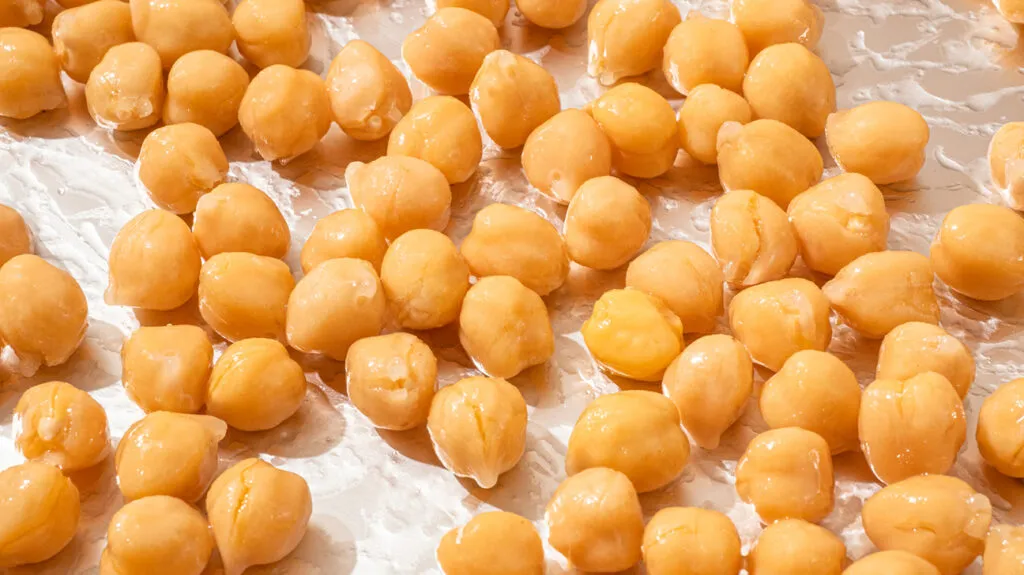Chickpeas, or garbanzo beans, are a type of legume. The most common type has a round shape and a beige color, but other varieties are black, green, or red. Their nutrients have various health benefits.
Researchers (Trusted Source) believe chickpeas may have originated in the Levant and ancient Egypt. They are a type of pulse — the dry edible seeds within the pod of legumes.
Like other legumes, such as lentils, chickpeas are rich in fiber and protein. They also contain several key vitamins and minerals.
This article looks at why chickpeas can be a healthy choice and how to cook with them.
Benefits
Chickpeas contain a range of nutrients, including protein, which is necessary for bone, muscle, and skin health.
For people who do not eat meat or who are cutting down on meat consumption, a dish of chickpeas and rice, for example, can contribute a significant amount of protein to the diet. A cup of chickpeas provides almost one-third of an adult’s daily protein needs
The nutrients in chickpeas may also help prevent or benefit several health conditions, which we list below.
Diabetes
One cup of chickpeas, weighing 164 grams (g), provides 12.8 g of fiber. The 2020–2025 Dietary Guidelines for Americans recommend that adults consume 25.2–28 g of fiber per day, depending on age and sex.
Fiber may benefit people with diabetes, and the American Diabetes Association recommends legumes such as chickpeas as a source of dietary fiber.
A 2018 review (Trusted Source) of meta-analyses found that a high fiber diet may help lower blood glucose levels and reduce the risk of developing type 2 diabetes.
A 2021 review of studies concluded that eating pulses long-term may help improve glycemic control, reduce low-density lipoprotein (LDL) cholesterol, and help regulate body weight.
Chickpeas can also play a role in a healthy diabetes meal plan.
Bone health
The iron, calcium, and other nutrients in chickpeas can all contribute to healthy bone structure and strength. Legumes such as chickpeas can play a role in the diet of people who want to prevent osteoporosis.
Blood pressure
To prevent high blood pressure, experts recommend (Trusted Source) limiting the intake of added sodium, or salt, and increasing the intake of potassium. Potassium can help lower blood pressure by removing sodium from the body.
Current guidelines (Trusted Source) recommend that adults consume at least 4,700 milligrams (mg) of potassium per day.
A cup of chickpeas, weighing 164 g, provides 477 mg of potassium.
People who use canned chickpeas should check how much added sodium they contain. Cooking with dry chickpeas or those with lower added sodium can help limit the amount of salt in a meal.
A 2020 reviewTrusted Source concluded that reducing sodium intake can lower blood pressure in people both with hypertension, or high blood pressure, and in those without.
Adults should keep their sodium intake (Trusted Source) below 2,300 mg per day, while people ages 51 or over and those with risk factors for cardiovascular disease should consume less than 1,500 mg per day.
Heart health
The fiber, potassium, B vitamins, iron, magnesium, and selenium in chickpeas all support heart health.
Fiber helps decrease the risk (Trusted Source) of heart disease by lowering cholesterol levels in the blood. Chickpeas contain no cholesterol.
According to a 2016 review (Trusted Source), a diet rich in pulses such as chickpeas can help decrease LDL cholesterol, which can benefit heart health.
Cancer
Free radicals are toxic substances that accumulate in the body as a result of metabolism and other factors. As these toxins build up, they can damage cells and lead to a variety of health problems, including cancer.
Selenium and beta carotene in chickpeas act as antioxidants, which help the body remove free radicals.
A cup of chickpeas contains 6.1 micrograms (mcg) of selenium. The Office of Dietary Supplements (ODS) recommends that adults consume 55 mcg of selenium per day. It also notes that selenium’s antioxidant activity may help protect the body from cancer.
In addition, chickpeas are a good source of fiber, and a 2015 studyTrusted Source suggests that eating a diet with sufficient fiber can help reduce the risk of colorectal cancer.
Cholesterol
The 2016 review (Trusted Source) cited earlier analyzed studies surrounding chickpea consumption in both humans and animals. A small study from 2006 suggested that when people ate a diet with added chickpeas, compared with a diet with added wheat, for 5 weeks, they had lower LDL, or “bad,” cholesterol. Other studies, including a few on rats, found that eating chickpeas reduced both serum total cholesterol (TC) and LDL cholesterol.
The authors of the review suggest that chickpeas may benefit cholesterol due to their dietary fiber and protein content, along with enzyme inhibitors and tannins.
Mental health
A cup of chickpeas contains 70.2 mg of choline, which helps with brain and nervous system function. Choline plays a role in mood, muscle control, learning, and memory, as well as the body’s metabolism.
The ODS recommends that adults consume 400–550 mg (Trusted Source) of choline a day, depending on sex and whether they are pregnant or breastfeeding.
Some research (Trusted Source) suggests that a selenium deficiency may increase the risk of cognitive decline in older people. This would imply that selenium may support cognitive health, including memory and thinking.
Digestion and regularity
Fiber helps keep the digestive tract healthy and promotes regularity and ease. Chickpeas and other legumes are a good source of fiber.
Studies outlined in the 2016 review (Trusted Source) on the nutritional benefits of chickpeas found that adding chickpeas to the diet resulted in significant increases in dietary fiber intake, which provided benefits to digestion and other body processes.
Weight management and satiety
Dietary fibers function as bulking agents in the digestive system. Bulking agents increase the feeling of fullness after eating, and protein has the same effect.
Feeling fuller for longer after eating can help reduce the appetite and lower a person’s caloric intake.
Pulses, such as chickpeas, contain both insoluble and soluble fiber, which can delay stomach emptying and slow the rate at which digested food travels through the small intestine, according to a 2017 review (Trusted Source). This can help people feel fuller longer.
Reduce chance of anemia
Without iron, the body cannot deliver oxygen to its cells, and this can lead to iron deficiency anemia. Symptoms include weakness and tiredness. In severe cases, life threatening complications can arise.
A cup of chickpeas contains 4.7 mg of iron, or between a half and one-fifth (Trusted Source) of a person’s daily requirement, depending on the individual. It also provides some vitamin C, which helps the body absorb iron.
Eating chickpeas regularly may help reduce the chance of developing an iron deficiency.
Nutrition
The following table shows the amount of each nutrient in 1 cup of chickpeas alongside daily requirements (Trusted Source). These requirements vary according to age and sex.
| Nutrients | 1 cup of chickpeas (164 g) | Requirements per day |
| Energy (calories) | 269 | 1,800–2,400 |
| Protein (g) | 14.5 | 46–56 |
| Fat (g) | 4.25 | 20–35% of daily calories should be fat |
| Carbohydrates (g) | 44.9, including 7.9 g of sugar | 130 |
| Fiber (g) | 12.8 | 22.4–33.6 |
| Calcium (mg) | 80.4 | 1,000–1,300 |
| Iron (mg) | 4.7 | 8–18 |
| Magnesium (mg) | 78.7 | 310–420 |
| Phosphorus (mg) | 274 | 700–1,250 |
| Potassium (mg) | 477 | 2,300-2,600 |
| Zinc (mg) | 2.5 | 8–11 |
| Copper (mcg) | 0.6 | 890–900 |
| Selenium (mcg) | 6.1 | 55 (Trusted Source) |
| Vitamin C (mg) | 2.1 | 75–90 |
| Folate (mcg) | 280 | 400 |
| Choline (mg) | 70.2 | 425–550 (Trusted Source) |
| Beta carotene (mcg) | 26.2 | 700–900 (Trusted Source) |
| Vitamin E (mg) | 0.6 | 15 |
| Vitamin K (mcg) | 6.6 | 75–120 |
For people following a vegan or vegetarian diet, adding chickpeas to their diet may provide protein, iron, selenium, and B vitamins.
Diet and recipes
People can buy dried or canned chickpeas year-round in grocery stores. Their nutty flavor and buttery texture make them easy to add to any meal.
Preparing dried chickpeas
1. Sort and wash: Depending on the supplier, there may be small rocks, dust, or other debris in the package.
2. Soak: Leave the chickpeas in water overnight or until they split easily between the fingers. Soaking dried legumes reduces the cooking time, helps break down ingredients that can cause gastrointestinal discomfort, and removes some harmful substances in raw legumes.
3. Cook: Drain and rinse the chickpeas, and then place them in a pan with plenty of water. Simmer on the stove until tender. Remember to top up the water from time to time. Other options include using a pressure cooker for 1 hour or in a slow cooker for 4 hours on high heat or 8 hours on low heat.
Tips for eating
Quick tips for incorporating cooked or canned chickpeas into a diet include:
- tossing chickpeas, vegetables, and a variety of other legumes — such as beans and lentils — in vinaigrette to make a protein-rich salad
- sprinkling some canned or roasted chickpeas into a salad to add texture and a nutty flavor
- using chickpea flour when baking to add fiber, protein, vitamins, and minerals
- blending chickpeas with olive oil, garlic, lemon juice, and tahini to make hummus, which can be a dip or spread
- adding chickpeas to a vegetable soup or stew to add nutrients, and serving with whole grain rice for complete protein
- using chickpeas to replace some or all of the meat in soups and stews
- mixing chickpeas with any spice for a delicious side or snack
- making falafel by mashing chickpeas with cumin, garlic, chili, and coriander, separating the mixture into small balls, and frying them until crisp
Or, try some of these healthy recipes:
- Berry spinach salad with maple cinnamon roasted chickpeas and balsamic dressing
- Snickerdoodle hummus
- Tomato and chickpea curry
- Chickpea and nut burgers with sweet potato chips
Risks
People should not eat raw chickpeas or other raw pulses, as they can contain toxins and substances that are difficult to digest.
Even cooked chickpeas have complex sugars that can be difficult to digest and lead to intestinal gas and discomfort.
A person should Introduce legumes into the diet slowly for the body to get used to them.
Fiber and IBS
Some types of fiber may worsen (Trusted Source) symptoms of irritable bowel syndrome (IBS).
Anyone with this condition should consult a doctor for advice about which forms of fiber to consume.
Allergies
People with allergies to other legumes, such as peas, lentils, and lupines, may also be allergic to chickpeas. People who have an allergy to other legumes should not eat chickpeas as severe allergic reactions can occur.
Chickpeas and potassium
Beta-blockers are a type of medication that doctors often prescribe for heart disease. They can cause potassium levels to increase in the blood.
Potassium can help manage blood pressure, but too much can harmful the kidneys. People who use beta-blockers should consume high potassium foods, such as chickpeas, in moderation.



